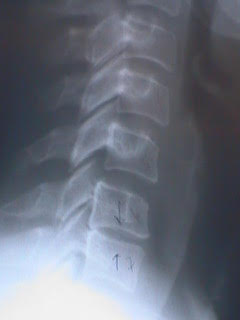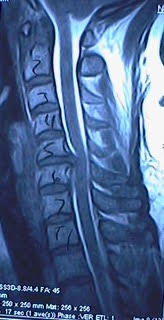Neck Arthritis
Neck arthritis often presents itself when an individual starts to frequently trip, stumble and fall or experience a significant loss of muscle strength in the arms and legs. It can be difficult to treat neck arthritis and most treatment is aimed and preventing further deterioration in mobility. If you believe you are experiencing neck arthritis, it is important that you are quickly and accurately diagnosed. Schedule an appointment today with the experts at Nebraska Hand & Shoulder Institute.
Neck Arthritis (Cervical spondylosis)
Cervical Spinal Stenosis
The majority of people with arthritis of the neck do not have significant symptoms. They will not require surgery on their neck. Cervical spinal stenosis means the canal is narrowed around the spinal cord from a degenerative disk disease and arthritis in the neck. In response to the settling of the vertebrae of one upon the other and the arthritic decay enlarging the facet joints in the back of the spine, the foramina (Latin for window) on each side of the spine at each level become narrowed. This can pinch a nerve root causing either pain or weakness. The spinal cord itself may suffer from the pressure and the person may start having “myelopathic” symptoms. This means they might develop a gait disturbance (stumbling, tripping on things, falling over easily, etc.) and it may affect their bowel or bladder. They may also have profound weakness in some of the muscles of the upper or lower extremities on one or both sides. Sometimes the symptoms come on rather abruptly. Once they develop, however, it is hard to get rid of them. A lot of the treatment is based on trying to prevent the process from worsening. Once it is determined that the person has this sort of problem the appropriate referral is made.


Shoulder & Neck Pain from the Carpal Tunnel
Most doctors and the general public are not aware that entrapment of a nerve as far down as the wrist can cause pain in the person’s shoulder or neck. This can be the only symptom a person comes in with, i.e. they may not be complaining of numbness, tingling, clumsiness, or any nighttime symptoms. Usually the shoulder pain experienced in a person who is getting it from entrapment of the median nerve in the carpal tunnel is going to be in the area between the neck and the top of the shoulder (the trapezius muscle area). Occasionally, it is directly in the neck and sometimes in the general shoulder area. Many people who come in with carpal tunnel syndrome that are over the age of 30 have another problem at the same time as the carpal tunnel syndrome and thus, shoulder pain from motion of the shoulder is more likely to be from impingement syndrome.
Shoulder or neck pain coming from the carpal tunnel typically disappears immediately or almost immediately within a matter of days of the carpal tunnel release surgery. We have no way of determining in advance whether the pain in a person’s shoulder or neck is going to be affected by their carpal tunnel release.

It has been shown that the results of treating carpal and cubital tunnel syndromes are not as good in patients with cervical spondylsosis and it is presumed to be related to the double crush phenomenon. It has never been thoroughly researched to determine if age is an independent variable. This is important because even though this degenerative arthritis is genetically determined, the decay becomes most evident with advancing age. It is also the elderly who tend to procrastinate the longest and present for care in a more advanced state of disease. There is a greater likelihood of other illnesses, such as diabetes, that influence the result of treatment.
[1] Khan, M.I. “Carpal tunnel syndrome: A curable cause of chronic neck pain.” Contemporary Orthopaedics, August 1988; Vol. 17, No. 2, pp. 29-__.
Kummel, B.M., Zazanis, G.A. “Shoulder pain as the presenting complaint in carpal tunnel syndrome.” Clinical Orthopaedics, May 1973; 92:227-___.



